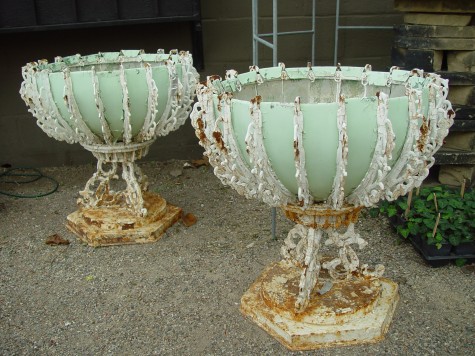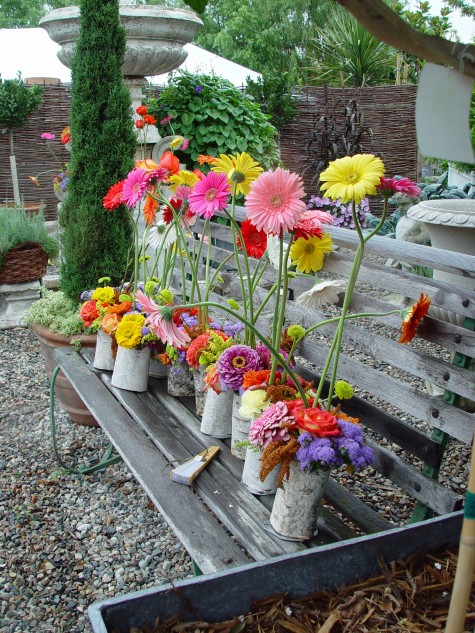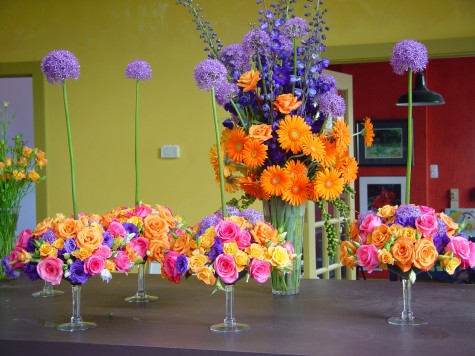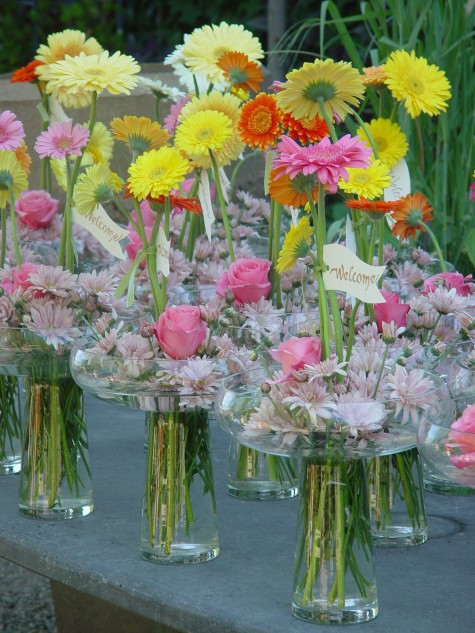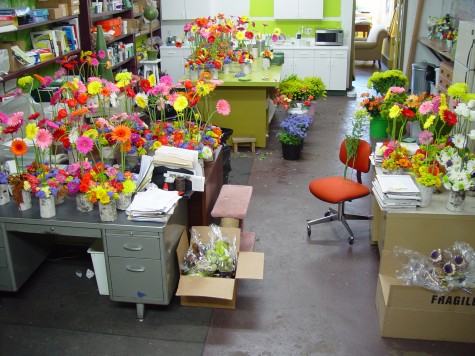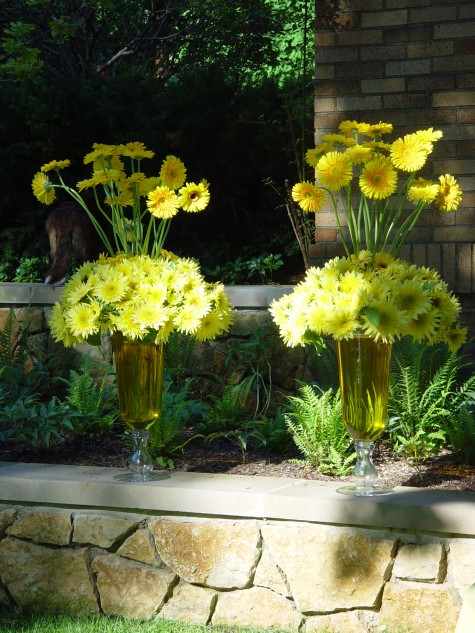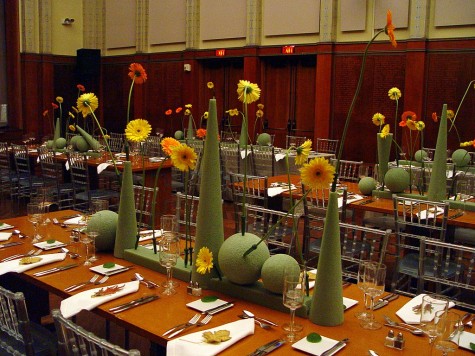 There was plenty to worry about with this year’s tour-most of the worries had to do with weather. Our extremely hot weather had been somewhat mitigated by regular and heavy rain, but that combination can also provide a forum for fungus of all descriptions. I have had some trouble keeping up with the water at my own house-but I was determined to let the chips fall where they may. I was not trying to secure a berth in the World Series of Gardening-I was trying to raise a little money for a worthy cause.
There was plenty to worry about with this year’s tour-most of the worries had to do with weather. Our extremely hot weather had been somewhat mitigated by regular and heavy rain, but that combination can also provide a forum for fungus of all descriptions. I have had some trouble keeping up with the water at my own house-but I was determined to let the chips fall where they may. I was not trying to secure a berth in the World Series of Gardening-I was trying to raise a little money for a worthy cause.
 Only a few days a year are the garden gates wide open; this is nice to see. What I see when I leave home in the morning, and what I drive up to at night-I have taken a lot of trouble to design this space. I see it every day, twice a day. This day was mostly overcast. Overcast days make the color of these Sum and Substance hostas seem especially intense; they so light up a shady spot. Light and dark, contrasting textures, a coherent view-these are things I am interested in as a designer. As a gardener, I have the patience to let a garden evolve.
Only a few days a year are the garden gates wide open; this is nice to see. What I see when I leave home in the morning, and what I drive up to at night-I have taken a lot of trouble to design this space. I see it every day, twice a day. This day was mostly overcast. Overcast days make the color of these Sum and Substance hostas seem especially intense; they so light up a shady spot. Light and dark, contrasting textures, a coherent view-these are things I am interested in as a designer. As a gardener, I have the patience to let a garden evolve.
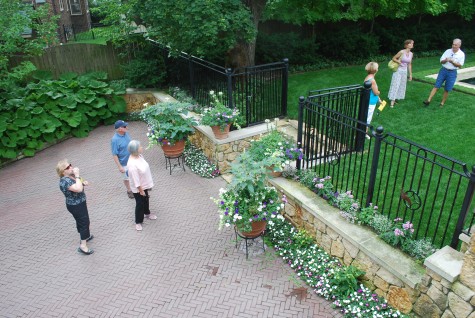 I grow lots of flowers at the end of my drive- as this is what I want to see when I drive up. It softens the iron of the fence, and gates. From the street, the fence, and these pots and the in ground plantings comprise the midground space of my view. I always find the midground space the hardest to deal with-near and far seems so much easier to resolve.
I grow lots of flowers at the end of my drive- as this is what I want to see when I drive up. It softens the iron of the fence, and gates. From the street, the fence, and these pots and the in ground plantings comprise the midground space of my view. I always find the midground space the hardest to deal with-near and far seems so much easier to resolve.
 My driveway ends is a large piazza-like space. It is interesting to see how people proceed from this point. How that driveway unexpectedly enlarges makes it the center of my landscape, from which all other possible paths radiate. Some went up the path to the north side garden. Some came into the pool yard first. Some lingered in this space, considering their decision about how to proceed. Watching how people use a space tells you a lot about how successfully you have planned it.
My driveway ends is a large piazza-like space. It is interesting to see how people proceed from this point. How that driveway unexpectedly enlarges makes it the center of my landscape, from which all other possible paths radiate. Some went up the path to the north side garden. Some came into the pool yard first. Some lingered in this space, considering their decision about how to proceed. Watching how people use a space tells you a lot about how successfully you have planned it.
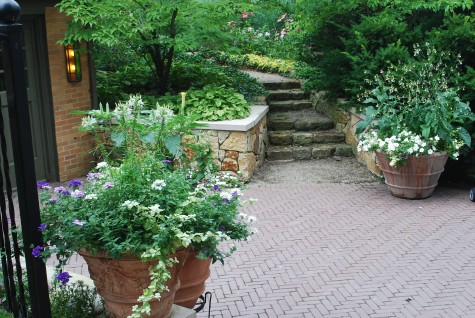 My north side garden is a very small space; there is not even that much to see. The main attraction is from the ground level. How the path curves out of immediate view invites a visitor to explore. I almost never use this path. It is enough for me, that it makes a visual invitation. I have been thinking I should place something up there to make the walk worth the trouble. But for now, the mystery of where this path might lead is enough.
My north side garden is a very small space; there is not even that much to see. The main attraction is from the ground level. How the path curves out of immediate view invites a visitor to explore. I almost never use this path. It is enough for me, that it makes a visual invitation. I have been thinking I should place something up there to make the walk worth the trouble. But for now, the mystery of where this path might lead is enough.
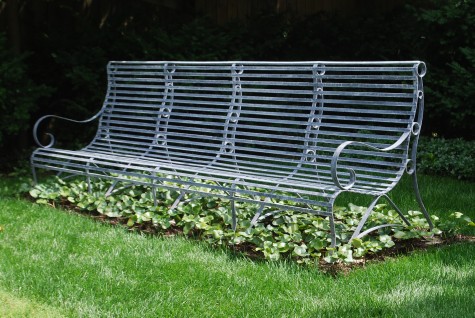 I have tried several different plants under this bench. The space needs to be planted with something other than grass,, as this 9 foot bench is very heavy, and too much trouble to move. Grass would be very unhappy with the shade cast by the bench. The European ginger seems to be quite happy here. The shiny leaves are a beautiful contrast to the cool bluish steel. The bench is set on several courses of brick, so it does not sink into the ground. Raising this bed to the level of the pool coping makes the bench at a much more comfortable height for me to sit.
I have tried several different plants under this bench. The space needs to be planted with something other than grass,, as this 9 foot bench is very heavy, and too much trouble to move. Grass would be very unhappy with the shade cast by the bench. The European ginger seems to be quite happy here. The shiny leaves are a beautiful contrast to the cool bluish steel. The bench is set on several courses of brick, so it does not sink into the ground. Raising this bed to the level of the pool coping makes the bench at a much more comfortable height for me to sit.
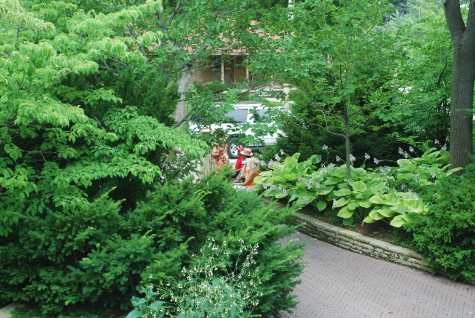 When I bought my house, the beds sloped down to the drive. There was always dirt and debris sliding out of the bed and onto the brick surface-a messy look. A low dry laid retaining wall of sandstone cleaned up the mess. It also made it easier to water my magnolias; a flat space under trees helps keep water from draining off before it can be absorbed. It also provides a perch, either to visitors, or to me, when I want to spend some time there. I was pleased to see that wall being used by guests.
When I bought my house, the beds sloped down to the drive. There was always dirt and debris sliding out of the bed and onto the brick surface-a messy look. A low dry laid retaining wall of sandstone cleaned up the mess. It also made it easier to water my magnolias; a flat space under trees helps keep water from draining off before it can be absorbed. It also provides a perch, either to visitors, or to me, when I want to spend some time there. I was pleased to see that wall being used by guests.
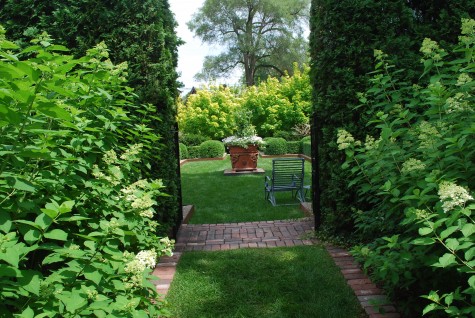 The front yard gates are only open once a year-on this day. The pool needs to be gated and locked, for safety reasons. The view with the gates open is very pretty-this was my favorite spot in the yard yesterday. As the rose garden is a sunken garden, the generous landing of old brick provides ample notice that there is a change of grade. The brick on the sides of the path neaten up a space adjacent to the hydrangeas, where grass is reluctant to grow. I like the simplicity of the brick, rather than introducing another plant.
The front yard gates are only open once a year-on this day. The pool needs to be gated and locked, for safety reasons. The view with the gates open is very pretty-this was my favorite spot in the yard yesterday. As the rose garden is a sunken garden, the generous landing of old brick provides ample notice that there is a change of grade. The brick on the sides of the path neaten up a space adjacent to the hydrangeas, where grass is reluctant to grow. I like the simplicity of the brick, rather than introducing another plant.
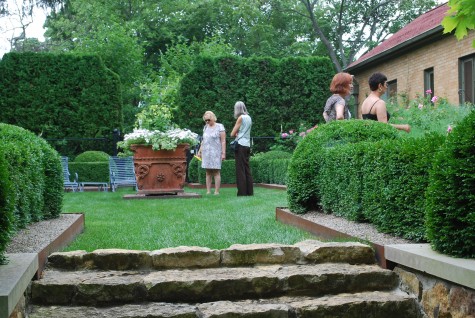 I am always keen to have visitors to the garden. They ask about things, and make comments that would never occur to me. Someone else’s point of view can help me to get moving when I feel stuck. Most gardeners are very positive in their commentary, and not at all concerned whether their advice gets taken to heart. Some things they notice make me realize my emphasis might be misplaced, or not strong enough. If you are confident to ask others what they think, something good might just come of what you hear. If what you hear is too far afield, say thanks and move on. Good gardeners trust their instincts.
I am always keen to have visitors to the garden. They ask about things, and make comments that would never occur to me. Someone else’s point of view can help me to get moving when I feel stuck. Most gardeners are very positive in their commentary, and not at all concerned whether their advice gets taken to heart. Some things they notice make me realize my emphasis might be misplaced, or not strong enough. If you are confident to ask others what they think, something good might just come of what you hear. If what you hear is too far afield, say thanks and move on. Good gardeners trust their instincts.

My neighbors, Fred and Jean, will be moving back to England this fall. This is their third year, tending the tour for me. They always come round before the tour to go over the new plants, the old plants, what flowers are in the pots. They like to be able to answer questions, just like me. They attended horticulture school in England many years ago. I trust my garden to them. We all talked gardening yesterday until we had not one word left. I am quite sure we are just like other gardeners, in other states, and other countries-all over this planet. This part I really like.
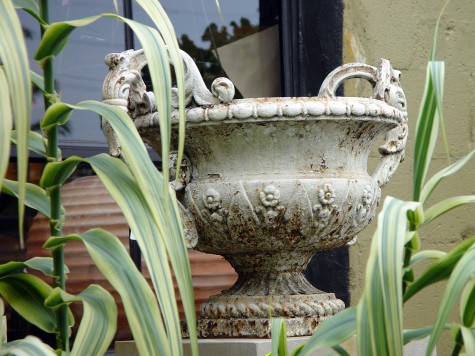 Gardeners make choices based on lots of issues, but most can figure out what appeals to them straight off. Some love old crusty, rusty and well worn antiques; others find that state of gentle disrepair lacks visual punch. Many antique urns have been painted at one time or another; white having been a very popular color. Worn white will either be just the thing, or seem jarring. For others, the prospect of a classical urn leaves them cold-old or new. But if the idea of an urn resonates with you, which you will choose depends on several things.
Gardeners make choices based on lots of issues, but most can figure out what appeals to them straight off. Some love old crusty, rusty and well worn antiques; others find that state of gentle disrepair lacks visual punch. Many antique urns have been painted at one time or another; white having been a very popular color. Worn white will either be just the thing, or seem jarring. For others, the prospect of a classical urn leaves them cold-old or new. But if the idea of an urn resonates with you, which you will choose depends on several things. 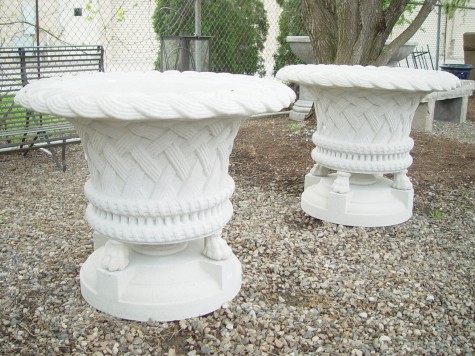 Dry cast limestone urns are usually based on classical handcarved limestone designs dating back hundreds of years. Many of those designs are European in origin. Dry cast limestone is a process by which limestone dust is mixed with a binder, and poured into molds. These reproductions are much more affordable than their antique counterparts. Some old designs would not be available at all, but for a reproduction. On occasion I find a piece I feel I must have, with no placement in mind. But a classical European urn may be very much out of place in front of a Cape Cod home. Now would these elaborately footed urns ring right against the backdrop of my own arts and crafts style home. However, they might be elegant and unexpectedly beautiful in a contemporary setting. The location you have in mind should influence your decision.
Dry cast limestone urns are usually based on classical handcarved limestone designs dating back hundreds of years. Many of those designs are European in origin. Dry cast limestone is a process by which limestone dust is mixed with a binder, and poured into molds. These reproductions are much more affordable than their antique counterparts. Some old designs would not be available at all, but for a reproduction. On occasion I find a piece I feel I must have, with no placement in mind. But a classical European urn may be very much out of place in front of a Cape Cod home. Now would these elaborately footed urns ring right against the backdrop of my own arts and crafts style home. However, they might be elegant and unexpectedly beautiful in a contemporary setting. The location you have in mind should influence your decision.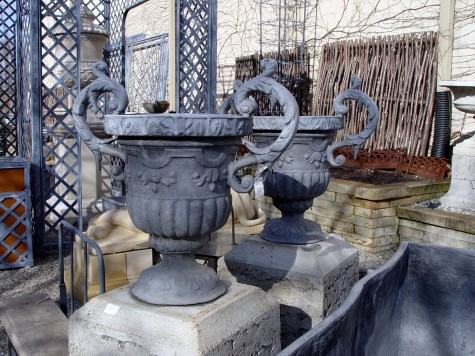 The scale of an urn is an important consideration. Very small urns may need pedestals to set them off properly. If the shape and decoration of an urn is a good bit of what you find appealing, then they need be placed where those things can be easily seen. Small urns have another significant disadvantage. From a small size follows a small planting area; you will need to edit your plant choices. Perhaps of more importance-how easily will you be able to water, and water again, when the weather gets hot? Small pots dry out faster than is easy to keep up with.
The scale of an urn is an important consideration. Very small urns may need pedestals to set them off properly. If the shape and decoration of an urn is a good bit of what you find appealing, then they need be placed where those things can be easily seen. Small urns have another significant disadvantage. From a small size follows a small planting area; you will need to edit your plant choices. Perhaps of more importance-how easily will you be able to water, and water again, when the weather gets hot? Small pots dry out faster than is easy to keep up with.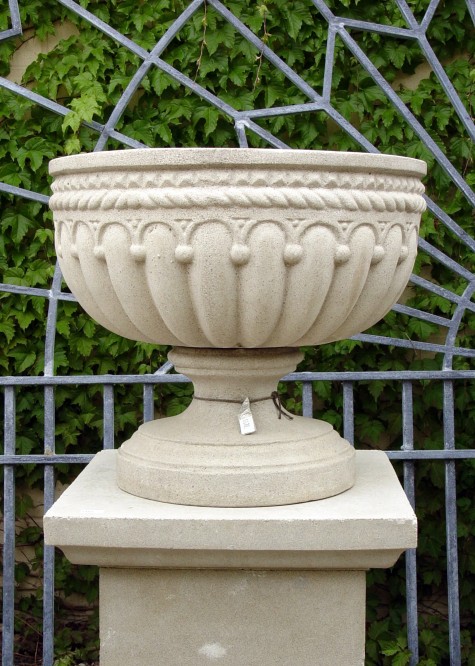 I like urns of a generous size. I have plenty of room to plant-either lots of one thing, or a collection. An urn planted such that in late summer it is a garden bouquet of good size is a pleasure. Watered properly, they retain moisture evenly, over a longer period of time. A container that can wait for me to get there with the hose- this I appreciate. Any urn I plant becomes part of the working garden. A gorgeous urn with a poor planting is a frustration no gardener needs.
I like urns of a generous size. I have plenty of room to plant-either lots of one thing, or a collection. An urn planted such that in late summer it is a garden bouquet of good size is a pleasure. Watered properly, they retain moisture evenly, over a longer period of time. A container that can wait for me to get there with the hose- this I appreciate. Any urn I plant becomes part of the working garden. A gorgeous urn with a poor planting is a frustration no gardener needs. 
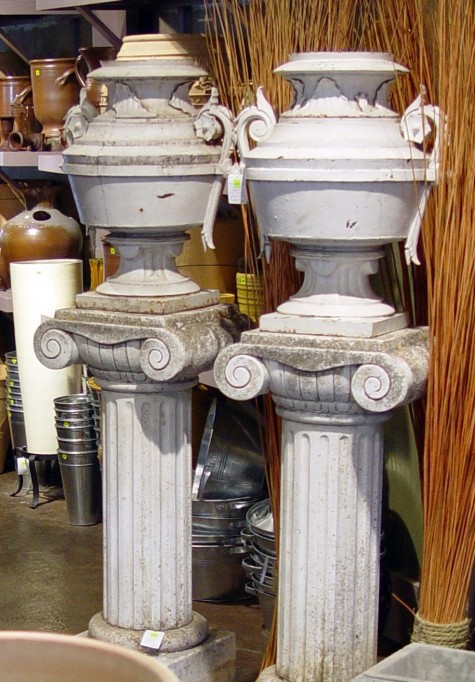 These French art deco style urns have such style and presence one might be inclined not to plant them. The Waterloo Urn I discussed in yesterday’s post is placed out in the open landscape. Unplanted, it could be placed anywhere calling for a sculpture-no need to have water conveniently nearby.
These French art deco style urns have such style and presence one might be inclined not to plant them. The Waterloo Urn I discussed in yesterday’s post is placed out in the open landscape. Unplanted, it could be placed anywhere calling for a sculpture-no need to have water conveniently nearby. 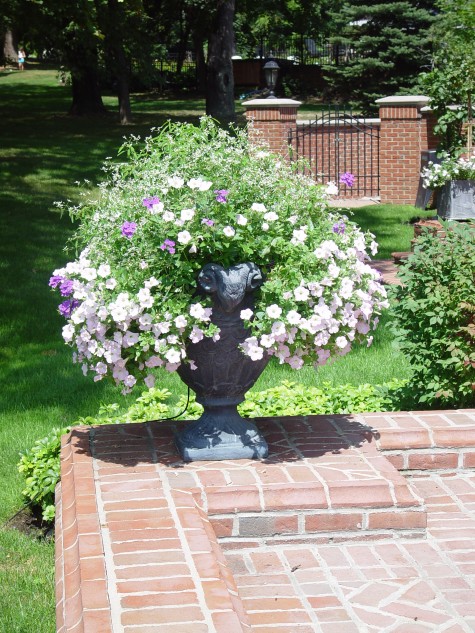 This lead urn is watered via a tube connected to the irrigation system in this yard. In much the same way as greenhouses tube their hanging baskets, or geraniums, these tubes buy a gardener a little time. They are not really a substitue for hand watering, as the coverage can be uneven, too long, or too short. If the tube runs on a nearby irrigation zone, that pot is at the water mercy of whatever else is being primarily watered. I am more than willing to look after my plantings; some automatic irrigation helps me to hedge this pledge. Those days that I come home really late will not need be a crisis. The level of your ability to maintain pot plantings is an important part of the selection process.
This lead urn is watered via a tube connected to the irrigation system in this yard. In much the same way as greenhouses tube their hanging baskets, or geraniums, these tubes buy a gardener a little time. They are not really a substitue for hand watering, as the coverage can be uneven, too long, or too short. If the tube runs on a nearby irrigation zone, that pot is at the water mercy of whatever else is being primarily watered. I am more than willing to look after my plantings; some automatic irrigation helps me to hedge this pledge. Those days that I come home really late will not need be a crisis. The level of your ability to maintain pot plantings is an important part of the selection process.  These concrete pots are English made reproductions, but they have that aged look. The surface is such that I would plant the tall, and vase shaped-nothing trailing. Ala some voluminously opulent Flemish flower painting. There is no choosing these pots if the decorative story being told does not greatly appeal-why cover up what so appealed to you in the first place? In this case, the urns and there plantings need to strike a balance, so they look great in relationship to one another.
These concrete pots are English made reproductions, but they have that aged look. The surface is such that I would plant the tall, and vase shaped-nothing trailing. Ala some voluminously opulent Flemish flower painting. There is no choosing these pots if the decorative story being told does not greatly appeal-why cover up what so appealed to you in the first place? In this case, the urns and there plantings need to strike a balance, so they look great in relationship to one another. 